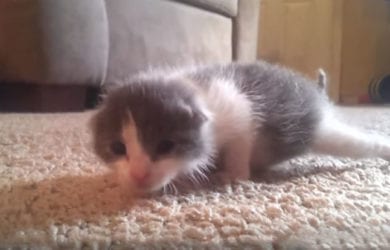Fading Kitten Syndrome is not a single disease but rather a collection of symptoms associated with failure to thrive in neonatal kittens. It’s effects vary from mild to extreme conditions the worst of which may be fatal.
FADING KITTEN SYNDROME
Young kittens are extra vulnerable to all kinds of medical conditions and viruses because their immune system isn’t fully developed yet. Once infected, they deteriorate fast. In it’s advanced stages Fading Kitten Syndrome is often fatal and many kittens don’t make it. But you can contain it if you monitor and catch it on time.
CAUSES
There are many varying conditions that cause Fading Kitten Syndrome. These conditions range anywhere from environmental issues, parasites, congenital defects, and viral infections. According to experienced veterinary technicians, human error among caregivers may also lead to Fading Kitten Syndrome.
Young neonatal kittens have weak immune systems that can cause a downward spiral in the kittens’ health. For example, minor diarrhea can quickly escalate into dehydration and then hypothermia. The kittens’ frail body quickly succumbs to failure of major body functions. So the smallest of issues can cause major damage if left unattended.
Without prompt intervention, any number of factors can trigger fading kitten syndrome. Without prior knowledge on the causes of fading kitten syndrome, it is impossible to treat and save the kitten’s life in time.
SYMPTOMS
- The initial signs of Fading Kitten Syndrome are lack of enthusiasm.
- Disinterest in nursing may also be a warning sign.
- Another common indicator can be a kitten sleeping separately from the litter.
- Reduced elasticity in the skin also indicates dehydration. Dehydration is one of the most devastating conditions to an ailing kitten.
- Progressive conditions include the kitten’s face turning into a gaunt triangular indicating inadequate nutrition.
- Failure to gain weight normally or weight loss in extreme cases. A kitten’s weight must be monitored frequently to identify fading kitten syndrome symptoms early on.
when caring for neonatal kittens one must always be on their tows to be able to respond to symptoms immediately. Since it is hard to know what to look for when it comes to fading kitten syndrome many remain in the dark until it is too late.
If your kitten shows any of the above symptoms, rush it to a vet. Immediate response goes a long way in saving the kitten’s life and preventing the spread of disease. So if you’re caring for newborn kittens it is best to have a vet who is experienced in feline pediatrics available at all times.
TREATMENT OPTIONS
Finding the right treatment of fading kittens can be frustrating and depends on the severity of the syndrome and swift diagnosis. This makes having an experienced feline pediatric vet available all the more crucial.
As opposed to more sever cases, some cases of the syndrome that are caused by human error are easy to diagnose and correct rather easily.
When treating fading kitten syndrome it is important to treat both the cause of the fading condition and the secondary symptoms.
The treatment is determined by an accurate and timely diagnosis. For example, there are treatable illnesses such as respiratory infections and intestinal parasites. Most fading kittens will also suffer from secondary symptoms such as dehydration, which require supportive care as well.
Waiting too long is dangerous. You may not be able to salvage the condition of kittens with advanced problems. Late signs that show advanced fading kitten syndrome include; abnormal breathing, neck aching, and extreme lethargy. Odd vocalizations also indicate an advanced stage in the fading condition. In such a case, the vet will determine if the condition is curable. If not, euthanasia is the most reasonable and humane option.
HELPING FADING KITTENS
If you care for neonatal kittens, it is important to acquit yourself with knowledge of saving fading kittens. One of the primary methods used to save the life of a fading kitten in early stages of the condition, is by tube feeding. Many kittens at this point may not have the energy to suckle or the ability to swallow and could rapidly deteriorate.
Another effective method of maintaining hydration is the use of fluid therapy. Hydration helps to keep the kitten’s body functioning properly. But you will need accurate doses prescribed by an experienced vet to achieve this.
The most important components are Iron and vitamin B12.
CONCLUSION
Acquiring the knowledge and skills to save fading kittens is critical. Proper understanding of the symptoms and consulting experienced veterinaries will raise the chances of survival of fading kittens. Development of this condition isn’t necessarily a death sentence for a kitten. Instead, the caregiver should focus on quick responses that will raise the possibility of recovery.
By planning ahead, a caregiver can give a fading kitten the second chance at a healthy life. So focus on creating a good relationship with a reliable vet, learn ll about the early signs of Fading Kitten Syndrome, monitor your kittens with daily checks, and acquire advanced life-saving tactics.

